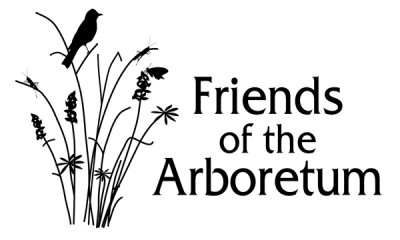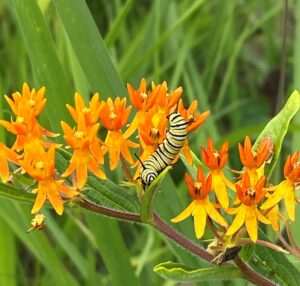Karen Oberhauser
Director,
University of Wisconsin-Madison Arboretum
If you’re older than about 40, have spent a lot of time outside in the Upper Midwestern U.S. since you were a child, and have an eye for butterflies, you’ve probably noticed a decline in monarch butterfly numbers since your childhood. Perhaps you’ve searched for monarch eggs and caterpillars in milkweed plants, brought in a few every summer to raise on your kitchen table, or marveled at the adults as they flew by on the roadside, soared over open fields, or visited your backyard garden. If you are noticing fewer, the decline you’ve seen is backed up by data from monitoring programs that document eggs and caterpillars on milkweed (the Monarch Larva Monitoring Project, coordinated jointly by the UW-Madison Arboretum and the Monarch Joint Venture – www.mlmp.org) or the area occupied by monarchs in their overwintering sites in Mexico (see graph at www.monarchbutterflyfund.org). Scientists use data from projects like these to understand drivers of the decline, and to set conservation goals.
Before thinking about why monarchs are having a tough time and what we can do to help them, it’s useful to understand their amazing annual cycle of breeding, migration, and overwintering. Most of the monarchs we see the Upper Midwestern U.S. in late August and September are heading south to central Mexico, where they’ll stay on high mountaintops all winter. Unlike their spring and summer counterparts, these individuals do not reproduce a few days after emerging as adults, but wait until mid-March, when they mate and lay eggs on milkweed plants as they move northward. These butterflies get as far as the middle of the U.S. before their 8-9 month lifespan is over. Their offspring are much shorter-lived, starting to breed soon after emerging and only living 4-6 weeks as adults. They continue the northward flight where their parents left off, laying eggs as they recolonize their summer breeding range—approximately the northeastern quarter of the U.S. and border areas of Canada. There are then 2-3 non-migratory generations before the migratory cycle starts again with the final generation of the year. The adults in every generation depend on available nectar plants to fuel flight and reproduction. Another population west of the Rocky Mountains follows a similar pattern, migrating to sites along the California coast. This migratory pattern leaves monarchs vulnerable at many places; for the cycle to continue, they need safe habitat and suitable weather in their vast breeding grounds, along their migratory pathways, and at their much smaller winter sites.
What drivers caused monarch numbers to plummet over the past few decades? Not surprisingly, weather plays a role. Hot and dry conditions tend to be associated with low monarch numbers, and so do cool and wet conditions. Like Goldilocks, monarchs prefer conditions that aren’t too hot or too cold, but “just right”. The effects of weather are complex, but in general, monarch migration has evolved over eons, and changes in the conditions they experience over the course of their annual migratory cycle present challenges to the butterflies themselves and the milkweed and nectar plants they depend on. Climate change has big impacts on monarchs and many other species, including humans, and it is important that we do what we can to minimize greenhouse gas emissions.
But the decline in monarch population is also associated with habitat loss. The organisms that depended on rich and diverse ecosystems before European settlement were pushed into the margins as bountiful prairies were converted to agricultural lands of the central US – the roadsides, hedgerows, and less desirable land that couldn’t be easily farmed. In a way, monarchs were lucky because they used a host plant that grew well in these margins, and could tolerate “old-fashioned” weed control methods in the fields themselves. However, changes in weed control practices meant that “corn-belt” land where monarchs’ milkweed host plants used to grow between corn and soybean rows is no longer available. Most corn and soybeans are now genetically modified to withstand herbicides (starting with glyphosate or Round-up, and now including several other herbicides) that kill milkweed. Unfortunately, monarchs’ luck has run out, at least with respect to row-crop fields, and in many places even the margins are being turned into agricultural fields.
As was so evident in summer 2021, different parts of monarchs’ range can experience very different weather conditions; while the western US was burning with hot and dry conditions, the eastern US suffered severe storms, and we in the Midwestern US had a fairly “normal” summer. Having as much habitat as possible available over the entire range of monarchs will increase the chances that they have a good year somewhere.
The good news is that so many people are motivated to help monarchs, and that monarchs can live in small pieces of good habitat (and even some not-so-good habitat; I’ve found them on milkweed plants growing in cracks in the sidewalk). In a single year, a lawn can be converted to a habitat that resembles the prairie or savanna that was here before, harboring dozens of species of the birds and insects that used to live here, including, if we plant milkweed, monarchs.
You can help, right in your own backyard, to save a familiar butterfly that you’re probably seeing less of lately. If you make some space for that familiar butterfly, your backyard habitat can act as a bridge to other habitats, creating a habitat corridor. Neighbor after neighbor, planting milkweed and linking nature preserves and neighborhood parks, can help to create habitat corridors that can help all pollinators.

